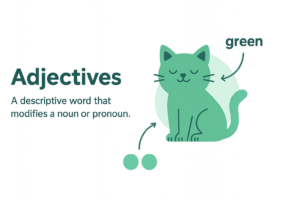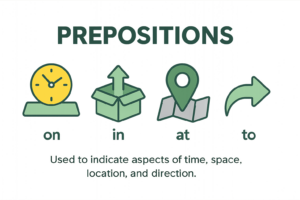Still have questions? Leave a comment

Checklist: Dissertation Proposal
Enter your email id to get the downloadable right in your inbox!

Examples: Edited Papers
Enter your email id to get the downloadable right in your inbox!
Need
Editing and
Proofreading Services?

The 8 Parts of Speech | Types, Uses & Examples
 Apr 08, 2025
Apr 08, 2025 5
min read
5
min read
Did you know that every word in the English language can be classified into roughly eight categories? This means that around 170,000 words are sorted into eight simple categories, also known as parts of speech.
However, this categorization isn’t always easy to decipher, and incorrect categorization leads to grammatical errors. To help you use these categories correctly, we’ve explained what are the parts of speech with examples. Let’s start with a simple parts of speech definition.
What are the parts of speech?
Parts of speech are specific roles and functions of a word in the English language. You can also think of parts of speech as characters in plays, movies, and books, each one having its function. Although the number may vary, modern English classifies these words into the following eight categories:
- Nouns
- Pronouns
- Adjectives
- Verbs
- Adverbs
- Conjunctions
- Prepositions
- Interjections
These parts of speech can further be classified into two categories: open and closed classes. Closed word classes, such as pronouns and prepositions, do not readily acquire new words, contrasting with open-class words that evolve over time.
Open classes
The word classes where new words can be easily added are known as open classes. These include nouns, adjectives, verbs, and adverbs. Open classes contain a greater number of words as compared to closed classes.
Closed word classes
Parts of speech that are more resistant to change are known as closed classes. These include conjunctions, prepositions, and interjections. New words are rarely added to these classes.
Eight parts of speech
Each word in the English language performs one of eight roles. These eight parts of speech can be better explained with the help of the following chart:
Let’s look at all these categories of parts of speech with examples:
1. Nouns
A name or title given to an object, person, group, or concept is known as a noun. It can either be the subject of a sentence (an individual who acts) or the object of the verb (receiver of the action).
Nouns can be further divided into common nouns (A generic term used to refer to somebody or something) and proper nouns (A specific name used to refer to an individual, place, or concept). The first letter of proper nouns always has to be capitalized, whereas the first letter of common nouns is only capitalized at the beginning of a sentence.
Other types of nouns include collective nouns, abstract nouns, and gerunds. Let’s look at the use of these nouns in a sentence.
- Collective noun: The team performed its best and won all the tournaments.
- Common noun: The inexperienced chef surprised everybody by creating a delectable dessert.
- Proper noun: Margot is vacationing in Normandy and Paris.
- Abstract noun: She finds happiness in traveling to different countries.
- Gerund: Swimming always manages to calm me down.
2. Pronouns
To avoid repetition, pronouns are used as stand-ins for nouns. A pronoun is usually used to indicate a noun that has already been mentioned. It can refer to people, places, objects, or concepts. Pronouns can further be divided into the following categories:
- Personal pronouns (I, you, he, she, it, we, they)
- Possessive pronouns (mine, yours, his, hers, its, ours, theirs)
- Demonstrative pronouns (this, that, these, those)
- Interrogative pronouns (who, whom, whose, what, which)
- Reflexive pronouns (myself, yourself, himself, herself, itself, ourselves, yourselves, themselves)
- Relative pronouns (who, whom, whose, which, that)
Let’s look at a few example sentences with these different types of pronouns:
- Personal pronouns: Maria is a party animal but values her alone time.
- Possessive pronouns: Lea is a voracious reader. The copy of The Death of Vivek Oji is hers.
- Demonstrative pronouns: This is my cat, Milo.
- Interrogative pronouns: Who do you think wrote the letter, and to whom was it addressed?
- Reflexive pronouns: After a long day at work, James treated himself to a relaxing spa session.
- Relative pronouns: The book that won the Pulitzer Prize is now a bestseller.
3. Adjectives
A descriptive word that modifies a noun or pronoun is known as an adjective. It elaborates on characteristics and provides descriptions of the subject they modify. This may include physical characteristics, qualities, or quantity of the subject.
Adjectives can either be placed before or after nouns or pronouns. Adjectives are used to describe nouns, providing detailed descriptions of objects, emotions, and experiences. Here is an example:
My father gifted me a blue pen before my exams. It was a lovely pen with dark blue ink.

4. Verbs
A word that indicates an action, an event, or a state of being is called a verb. It indicates the action the subject is performing by itself or on an object. A complete sentence must at least contain a subject and a verb.
Verbs can be altered according to the subject, tense, and tone of voice. They can further be divided into two categories:
- Regular verbs: Verbs whose simple past and past participle forms end with a d or ed.
- Irregular verbs: Verbs whose simple past and past participles are constructed differently.
Let’s take a look at examples of both these verbs:
Tara walked towards me and embraced me.
Jamil came to meet me.
5. Adverbs
An adverb is a descriptive word that gives more information about a verb, adjective, or another adverb. A rule of thumb to turn an adjective into an adverb is to simply add ly at the end. However, not all adverbs follow this pattern, such as “fast” and “well.”
Adverbs can be further divided into the following types:
- Adverb of manner: description of how something is done
- Adverb of degree: description of the extent something is taken to
- Adverb of place: description of where an event takes place
Here are a few examples of these adverbs in a sentence:
- Adverb of manner: Playing fast and loose will not always get you where you want.
- Adverb of degree: There is no normal; everyone is slightly deviant in their own way.
- Adverb of degree: Let’s get back inside, it’s raining cats and dogs.
6. Conjunctions
A conjunction is a word used to join two or more sentences, phrases, clauses, or words. There are three types of conjunctions:
- Coordinating conjunctions: Used to connect two grammatically equal entities.
- Subordinating conjunctions: Used to connect a dependent clause to an independent clause.
- Correlative conjunctions: Used to connect two grammatically equal parts of sentences.
Here are a few example sentences with all three types of conjunctions:
Most animals have a fight-or-flight response to potentially dangerous situations. (Coordinating conjunction)
Although it was snowing very heavily, the schools were still open. (Subordinating conjunction)
Both Trixie and Katya like to indulge in psychological thrillers. (Correlative conjunctions)
7. Prepositions
A preposition is a word or phrase that indicates the relationship of the noun or pronoun with the rest of the sentence. Prepositions can be used to indicate aspects of time, space, location, and direction. A prepositional phrase consists of a preposition followed by a noun or pronoun, and it serves to modify another word in a sentence. Here are a few example sentences with prepositions:
Sam is the head of the department.
Capybaras swim with their heads above the water.
Shall we meet by the river at 6 pm?

8. Interjections
Interjections are exclamations that form a separate part of the sentence. They are used to indicate emotions such as awe, joy, pain, or hesitation. They can also be used as a command or a greeting. Here are some example sentences with interjections:
Wow! What a game.
Ouch! That hurt.
Psst! Do you have an extra pencil?
Hey! How are you today?
Shush! The baby is sleeping.
Other parts of speech
The following categories at one point were considered separate parts of speech, but are now more or less integrated with the other eight parts of speech. Let’s take a look.
Determiners
Determiners are words that describe the qualities of a noun, such as quantity, belonging as well as position. As per the traditional eight parts of speech, these are classified as adjectives or even pronouns.
Here are a few example sentences:
That is my chair.
Few people believe in the power of positive reinforcement.
We met plenty of tourists in Bangkok, many of whom were from our city.
Articles
Articles are used to modify a noun to indicate if it is general or specific. There are two types of articles.
- Definite articles (the): Used to indicate a specific version of a noun.
- Indefinite articles (a, an): Used to indicate a generic version of a noun.
Here are some examples of these articles:
A cow was lazily grazing in the meadow.
He noticed that an eye of the pigeon was red.
Although articles can be classified as a separate part of speech, they are generally included under the category of determiners.
Words functioning as multiple parts of speech
Certain words can function as multiple parts of speech depending on the way they’re used. Let’s look at a few example sentences with these words:
1. Run
The word run can function as a verb, noun, as well as an adjective, depending on how it’s used. Here are a few example sentences with the word run used in different contexts.
Richard runs by the lake every morning. (Verb)
We should start going for evening runs together. (Noun)
Edgar scored the top grade but Violet certainly gave him a run for his money. (Adjective)
2. Lead
The word lead can function as a noun as well as an adjective. Here’s how it’s used in both these cases:
She is the only lead we have. (Noun)
The lead surgeon failed to show up for the operation. (Adjective)
3. Work
Work can be used as a verb as well as a noun, depending on the circumstances. Here are a few example sentences of work in both contexts:
I usually leave work at 5:00 pm. (Noun)
You must work tirelessly to achieve success. (Verb)
These differences may seem trivial at first but are key to perfect writing. As editing and proofreading experts, we realize the importance of understanding grammar concepts for flawless writing.
We’ve created a useful list of resources to help you minimize such errors. We hope they help bring out the best in your words!
Frequently Asked Questions






